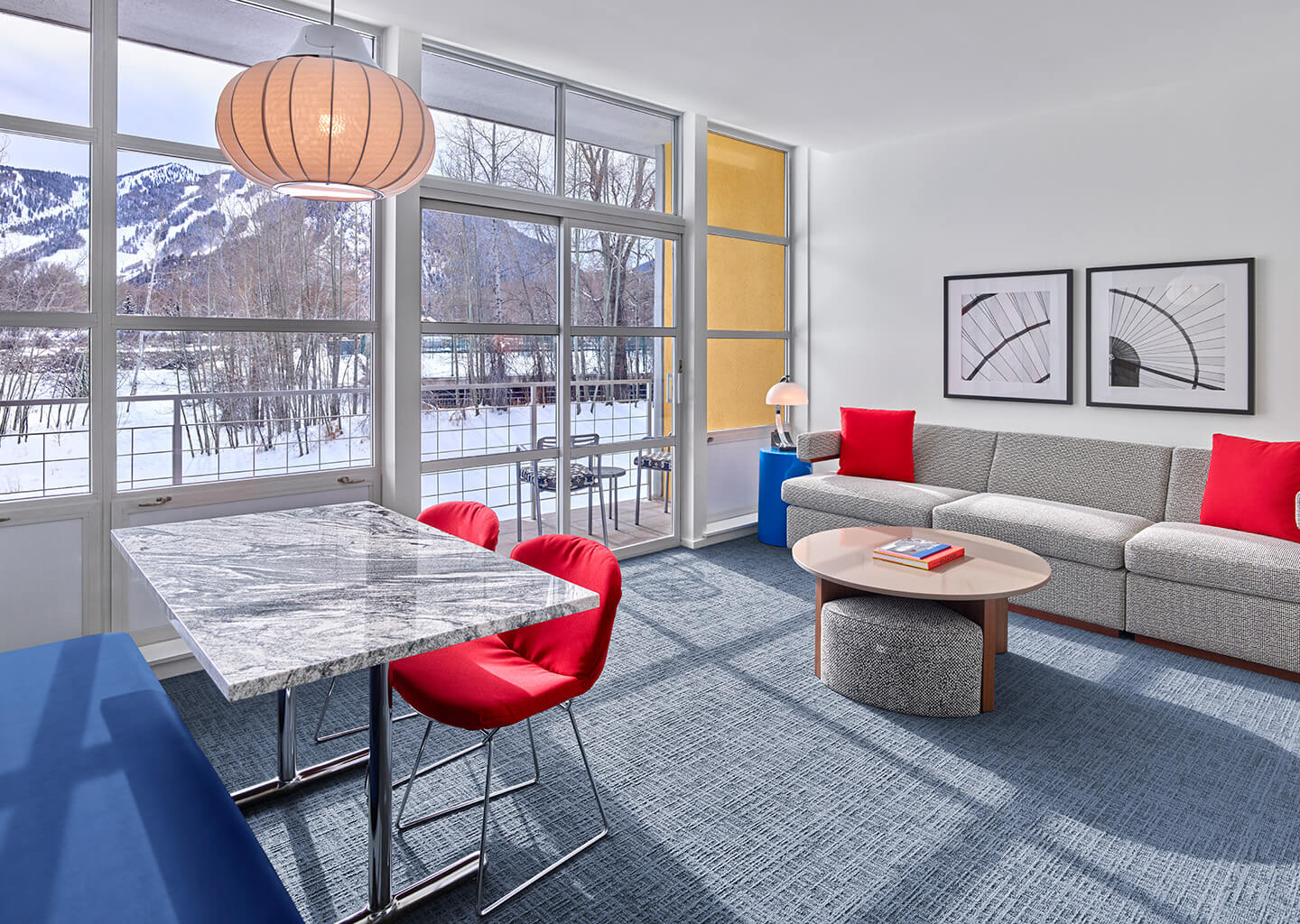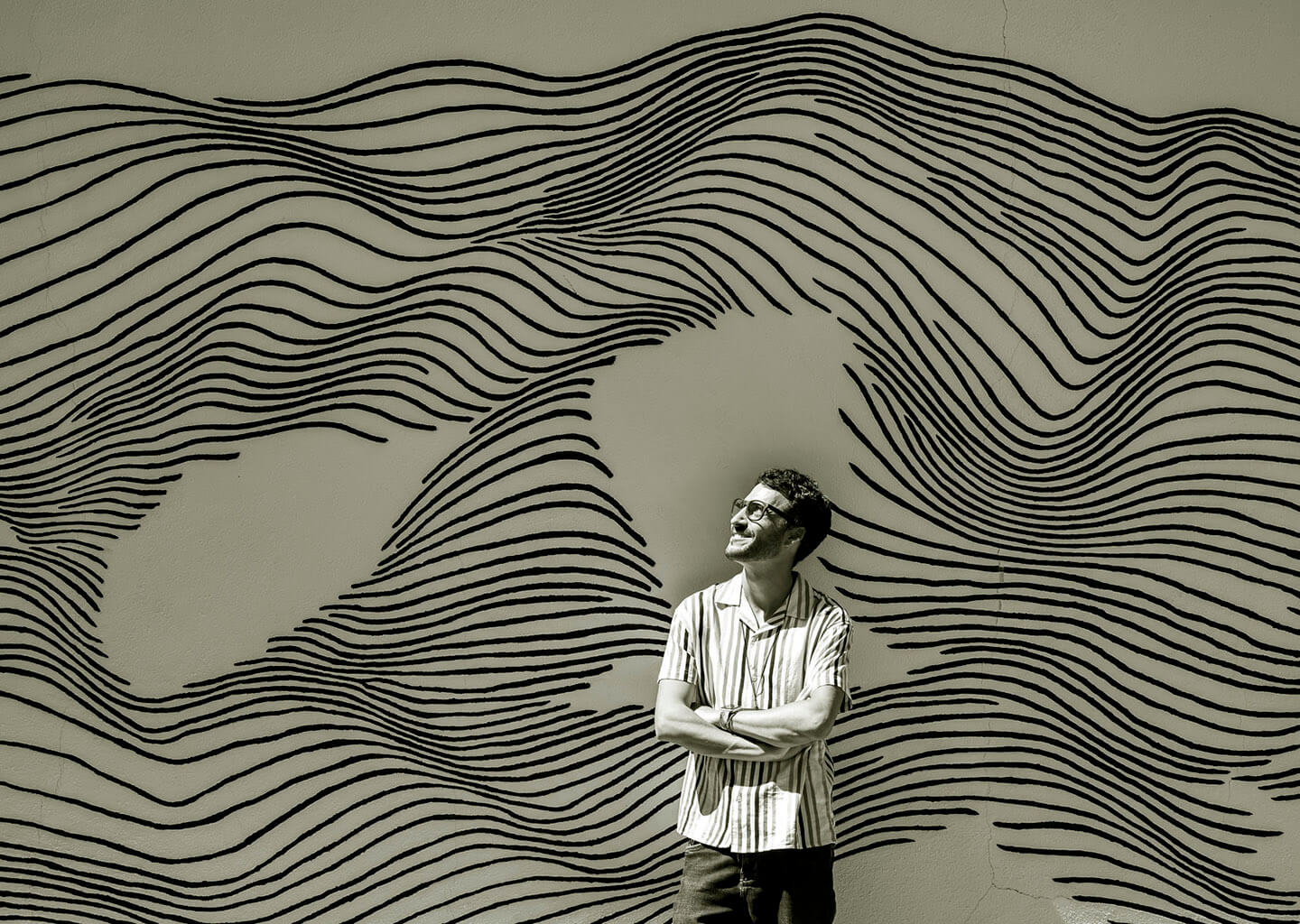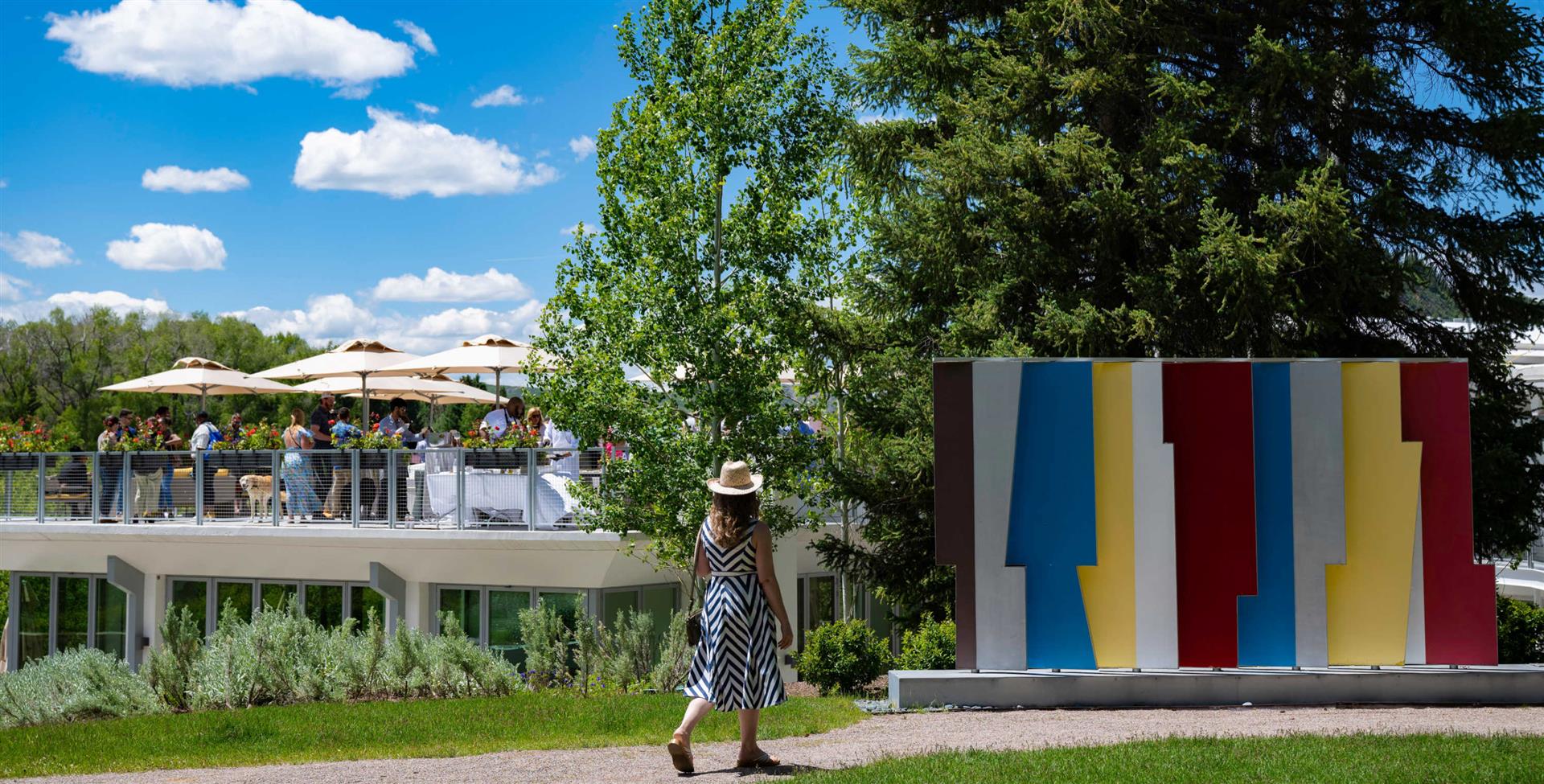The Aspen Meadows Campus Art Guide
Introduction to the Campus
In 1946, Walter and Elizabeth Paepcke, founders of the Aspen Institute, invited Bauhaus master artist and designer Herbert Bayer to relocate to Aspen to help transform an abandoned silver mining town into one of the world’s most popular destinations for leisure and culture. In 1949, they made Aspen the site for a celebration of the 200th birthday of the German poet and philosopher Johann Wolfgang von Goethe. The success of this 20-day event led the Paepckes to create the Aspen Institute for Humanistic Studies. Soon after, Bayer began designing a campus to help realize the utopian vision of a destination for influential thinkers.
Over the next twenty-five years, starting in 1953, Bayer implemented his concept of a unified total environment by creating a range of works from architecture to sculpture, murals, and earthwork on this forty-acre site of abandoned farmland. Bayer stated, “I am not so much concerned with the individual work of art, as with the total shape and content of the human scene.” Bayer fully embodied all the tenets of the Bauhaus school throughout his life, creating a total work of art by combining the various disciplines in virtually every project he undertook. The campus of the Aspen Institute is among his greatest achievements. His design for the campus matches the high aspirations of the Aspen Institute’s ideals to be a place where the human spirit, in all its complexity, can flourish.
Visitors today are welcome to enter the buildings to see Herbert Bayer’s paintings, prints, photographs, and tapestries, and to experience the myriad ways that art and architecture contribute to the spirit of the meeting, dining, and living spaces. Regular campus tours offer visitors an in-depth look at the development of this unique campus. For more information or to sign up for a tour, please visit thebayercenter.org. The Aspen Institute strives to reflect the Bauhaus spirit in igniting human potential to build understanding and create new possibilities for a better world.
The Aspen Meadows Campus Art Guide
Now available! Discover the stories behind the sculpture and land art throughout the Aspen Meadows campus with a new self-guided tour on the Bloomberg Connects app. Just scan the QR codes located next to each artwork to learn about the rich history and design legacy of this one-of-a-kind landscape designed by Herbert Bayer. Visitors can also sign up for complimentary guided walking tours led by landscape architect Ann Mullins.
1 Four Chromatic Gates
One in a series of gates designed by Herbert Bayer, this colorful cluster of rectangles welcomes visitors to the Aspen Institute campus on its southeast corner at Gillespie Street. The 16-foot sculpture is a distinctive marker for the Bayer Center and a bridge to the Aspen community.
2 The Resnick Center for Herbert Bayer Studies (The Bayer Center)
An exhibition space and center for the study of art. Named after Herbert Bayer (1900–1985), the Bayer Center honors his interdisciplinary perspective by presenting exhibitions and public programming. Free Admission.
3 Beottcher Seminar Building
This Bayer designed building—along with its two smaller buildings, or “pods,” connected by a walkway—houses three conference rooms and offices. Several of the rooms inside feature historic photographs by Ferenc Berko, former Institute photographer, dating from before the Institute’s groundbreaking.
4 Musser Japanese Garden
Entitled Sage Mountain Sky, this contemplative space was designed by notable Japanese garden designer Dr. David Slawson in 1994 in honor of former Aspen Institute trustee John Miller Musser.
5 Michael Klein Music Tent
This is the main performance venue for the Aspen Music Festival and School. Eero Saarinen designed the first tent for the Goethe Bicentennial in 1949, and Herbert Bayer designed the second tent in 1965. The current tent, erected in 2000, was designed by architect Harry Teague and seats 2,050.
6 Anaconda
Herbert Bayer hand-selected the Carrara marble from central Italy for this monumental seven-piece geometric sculpture. First installed in 1978 in the foyer of Atlantic Richfi eld’s Anaconda building in Denver, the Aspen Institute acquired the sculpture from the Denver Art Museum in 2017.
7 The Walter Paul Paepcke Memorial Building
Originally designed by Bayer in 1962 to honor Aspen Institute founder Walter Paepcke, this building was completely renovated in 2010. With a 400-seat auditorium, library, gallery, and the majority of the Aspen lnstitute’s staff offices, the building currently serves as the Aspen headquarters.
8 Paepcke Gallery
Housed in the Walter Paul Paepcke Memorial Building, this conference room displays a rotating suite of exhibitions.
9 David H. Koch Seminar Building
Completed in 1953, this was the first building constructed on the property. Bayer designed the hexagonal seminar rooms to accommodate six-sided discussion tables. The adjacent courtyard is a gathering space named in honor of William E. Mayer, a former Chairman of the Board of Trustees, and features busts of Mortimer Adler and Robert O. Anderson.
10 Sgraffito Wall
Designed by Herbert Bayer in 1953, this outdoor mural (located on the south side of the Koch building) reveals Bayer’s interest in the shifts and undulations of the earth’s surface. Sgraffito Mural is considered the culmination of Bayer’s “Mountains and Convolutions” series.
11 Intuition
The work of the British sculptor John Robinson, Intuition (1990) consists of three interlocking stainless steel triangles mounted on top of river rock.
12 Elizabeth Paepcke Memorial Wildflower Garden
Elizabeth Paepcke, one of the founders of the Aspen Institute, believed that experiencing nature was central to the experience of culture. She maintained a cherished flower garden at her Aspen home. In 1995, her daughters provided the initial funding to create this wildflower garden in her memory.
13 Geodesic Dome
Buckminster Fuller’s 36-foot-diameter dome was designed for the 1952 International Design Conference and was later used as a cover for the Aspen Meadows pool. This structure was fitted with a semispherical canvas, which was later re-canvased and restored in 2012.
14 Anderson Park
Designed in 1973, Anderson Park was one of Bayer’s final creations on campus. Dedicated in honor of the lnstitute’s second president, Robert O. Anderson, Bayer intended for visitors to climb, play, meditate or simply relax on the elevated berms. A small plaque commemorates Supreme Court Justice Harry Blackmun’s love of the campus, which he visited every summer between 1979 and 1995.
15 Amy’s Meadow
Originally a horse-racing track, this 13.5-acre meadow is now covered in sage and wildfl owers. A 2016 conservation easement ensures that this land will remain as open space in perpetuity. It is named in honor of former Institute Executive Vice President Amy Margerum Berg.
16 Big Dipper
German-born, Mexican artist Mathias Goeritz made this sculpture in 1973. Seen from above, star-shaped pillars form the shape of the Big Dipper. As with the real constellation, the imaginary line between the two stars furthest from the handle (the two tallest pillars) points to the North Star in the night sky.
17 The Residential Complex
The guest suites at the Aspen Meadows Resort are located in six separate buildings. Bayer designed and built the original residential complex, including the Trustee Housing, in 1954. The current guest suites were built in the early 1990s, faithful to Bayer’s original blueprints. The interiors were renovated again in 2008, 2015, and 2022.
18 Marble Garden
Bayer created Marble Garden in 1955 using 21 pieces of white marble reclaimed from Marble, Colorado, a quarry near Aspen. Through a balance of natural imperfection and geometrical experimentation, the arrangement creates an interplay of light and shadow, solid and void, man-made and natural form. Marble Garden was restored in 2021.
19 The Grass Mound
Herbert Bayer’s Grass Mound was completed in 1955. Notably, this is one of the first earthworks ever made, predating the land art movement by nearly ten years. This landscaping feature was conceived as an environmental design to enhance the surrounding open areas.
20 Doerr-Hosier Center
Built in 2007 and designed by architect Jeff Berkus, the Doerr-Hosier Center combines elements of modernism with inspiration from the natural world and Eastern philosophy. The building offers a large event space for 300 people, terraces, seminar rooms, a catering kitchen, the Resnick Gallery, Isaacson Room, and Andy Goldsworthy’s Stone River.
21 The Resnick Gallery and Isaacson Room
Downstairs in the Doerr-Hosier building is the Resnick Gallery and Isaacson Room, which are dedicated to exhibiting the work of Herbert Bayer. The gallery also features a permanent sandstone sculpture by Andy Goldsworthy.
22 Stone River
Built in 2007 in collaboration with architect Jeff Berkus, renowned artist Andy Goldsworthy’s sandstone serpentine wall winds into and through the Doerr-Hosier Center. Goldsworthy combined sandstone from areas of conflict around the world with local Colorado red sandstone to make a wall of unity, rather than division.
23 Resnick-Malek Health Center
The Health Center and the large “HC” mural are the work of Bayer. Constructed in 1955, the Health Center contains a fitness center, gymnasium, lap pool, changing rooms, saunas and hot tub. The Health Center is available to members and hotel guests.
24 Walter Isaacson Center
This resort reception center, designed by Herbert Bayer and opened in 1958, was renovated in 2024 and is now dedicated to Walter Isaacson, former president and CEO of the Aspen Institute. Herbert Bayer’s art is prominently displayed throughout.
25 Madeleine K. Albright Pavilion
The Reception Center was expanded in 2018 to accommodate additional indoor seating. The pavilion is named in honor of longtime Institute Trustee and former Secretary of State Madeleine Albright and includes the Bren and Mel Simon Terrace.
26 Kaleidoscreen
Finished in 1957, this Bayer sculpture was originally placed near the swimming pool to control air flow and shade by rotating the seven aluminum louvers. Kaleidoscreen was restored in 2023.






